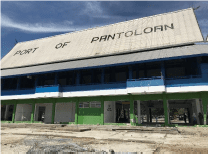





 Activities Summary
Activities Summary
 Tsunami Damage Observations
Building and infrastructure damage was observed during recognisance along the coastline from Tawaeli to Palu City. The survey team made two stops at Port of Pantoloan and Kampung Nelayan based on the recommendations of UNTAD colleagues. Damage characteristics were observed but not systematically recorded using a field data collection application.
Tsunami Damage Observations
Building and infrastructure damage was observed during recognisance along the coastline from Tawaeli to Palu City. The survey team made two stops at Port of Pantoloan and Kampung Nelayan based on the recommendations of UNTAD colleagues. Damage characteristics were observed but not systematically recorded using a field data collection application.
 Buildings
Buildings
 Noted that the ferry service was moved to another further north port prior the Palu-Dongala earthquake tsunami, hence limited human impact during the event.
Noted that the ferry service was moved to another further north port prior the Palu-Dongala earthquake tsunami, hence limited human impact during the event.
 |
 |
 |
 |
 |
 |
 |
 |
 |
 |
 |
 |
 |
 |
 |
 |
Written by Ben Payne
No-one involved in the Seismometers in Schools project wanted to see their work put into action as quickly as it was in Palu. In March 2018, three schools in the City of Palu had Raspberry Shake seismometers installed; on 28 September, a 7.5 magnitude quake in the North Sulawesi subduction zone and a subsequent tsunami killed at least 2100 people in Palu City, Donggala and Sigi. Nearly 700 are still missing and close to 80,000 people remain displaced.
A couple of days later, Richard Woods from the StIRRRD team noticed that the Raspberry Shake at the SMA Negeri Model Terpadu Madani (located in the north of the city of Palu) was back online, as power was restored to the school.
The seismometers in the three schools helped to build a picture of what happened that day. The severity of the shaking was obvious, and we can only imagine how terrifying the earthquake must have been.
The first image below shows the seismic trace up until the M7.5 struck just after 6pm. You can see the M6.1 foreshock earlier in the day and the aftershocks in between the two earthquakes. The second image shows the seismometer had power restored just after 12.15pm on 07/10, and the third image shows the UNTAD seismic trace on the 16th of October, interspersed with many aftershocks.



Richard then noticed that the Raspberry Shake located at MAN 1 school in the city of Palu, had also come back online, and like the first image above, the severity of the shaking is very clear.

For StIRRRD program leader Michele Daly and the wider team, the realities of the recent earthquake and tsunami are confronting. It’s one thing to be aware of the destructive potential of these natural hazards, but quite another to see events play out so soon. The StIRRRD team had visited Palu just six months before, and no-one could have predicted having to deal with such severe impacts so soon.
Michele described it as ‘heart-breaking’ to see so much destruction and human cost. But she was also amazed at how rapidly people have mobilised to support each other. She says that going by her experience of the wonderful people of Palu, she is sure this will continue throughout the recovery.
So, what are GNS Science and the StIRRD team doing to help?
The StIRRRD team is part of the response effort, supporting the Indonesian government and in-country partners with their response efforts. GNS Science has many experts in response and recovery following earthquake and tsunami events, and New Zealand’s Ministry of Foreign Affairs and Trade (MFAT) asked GNS and the StIRRRD team to lead a NZ inclusive approach, providing Palu with technical support in the transition from response to rehabilitation and recovery.
The immediate focus is to support MFAT and local agencies in Indonesia to carry out earthquake damaged building assessments and landslide risk assessment. The StIRRRD team are working with GNS experts and liaising with a variety of NZ and Indonesian partners, and this work is likely to continue in the longer term – with an emphasis on resilience and building back, better.